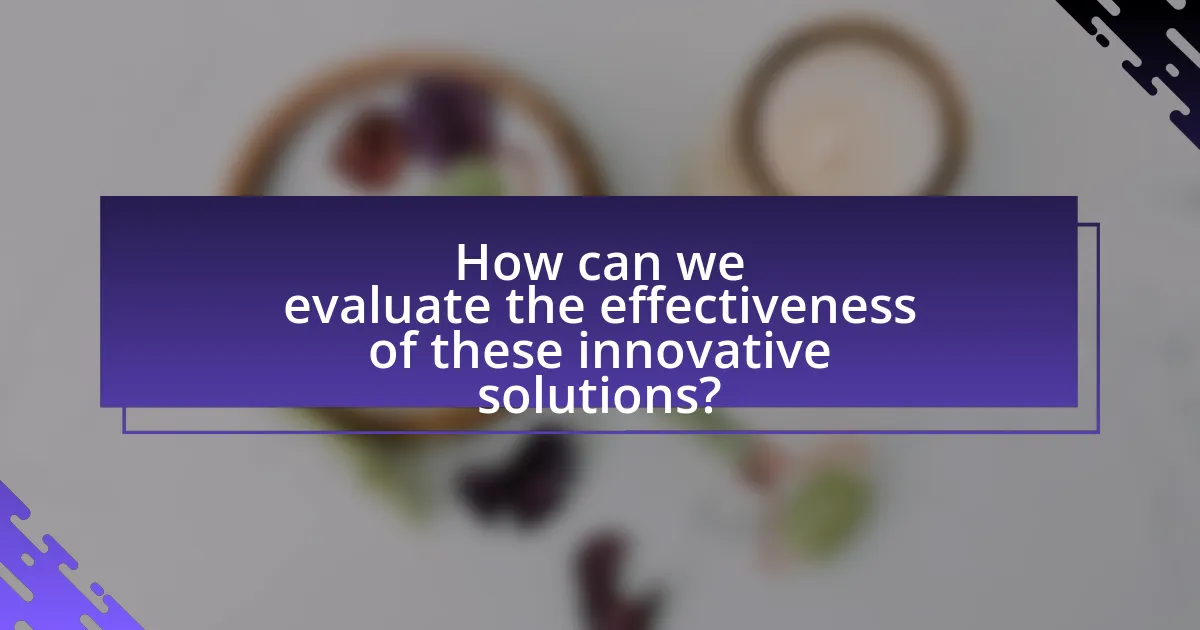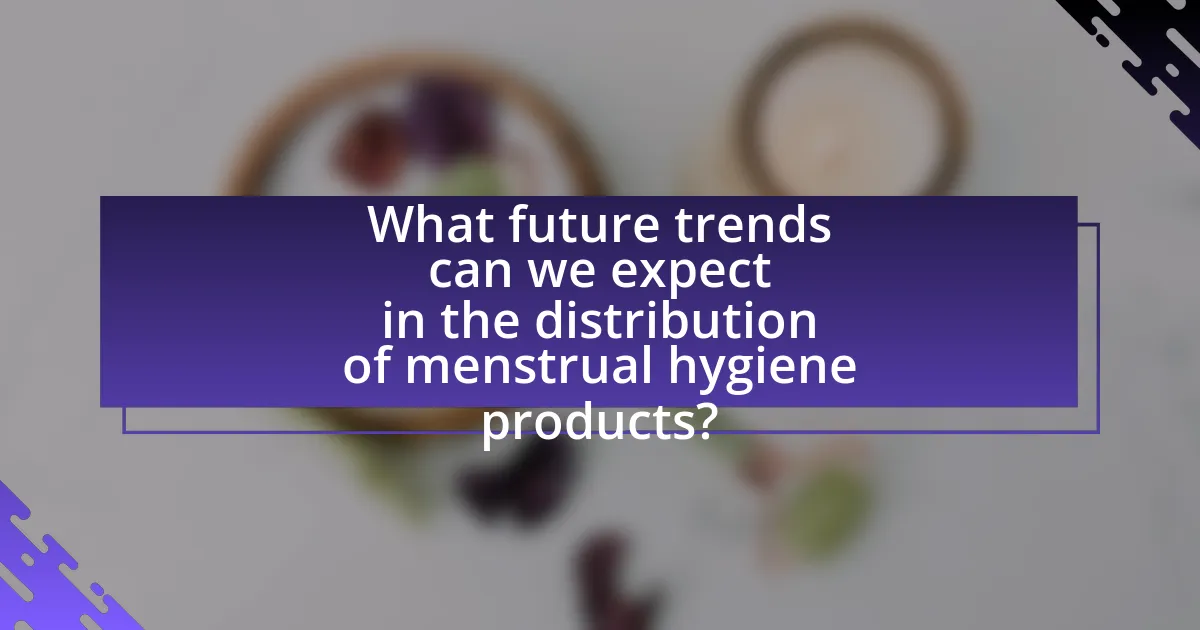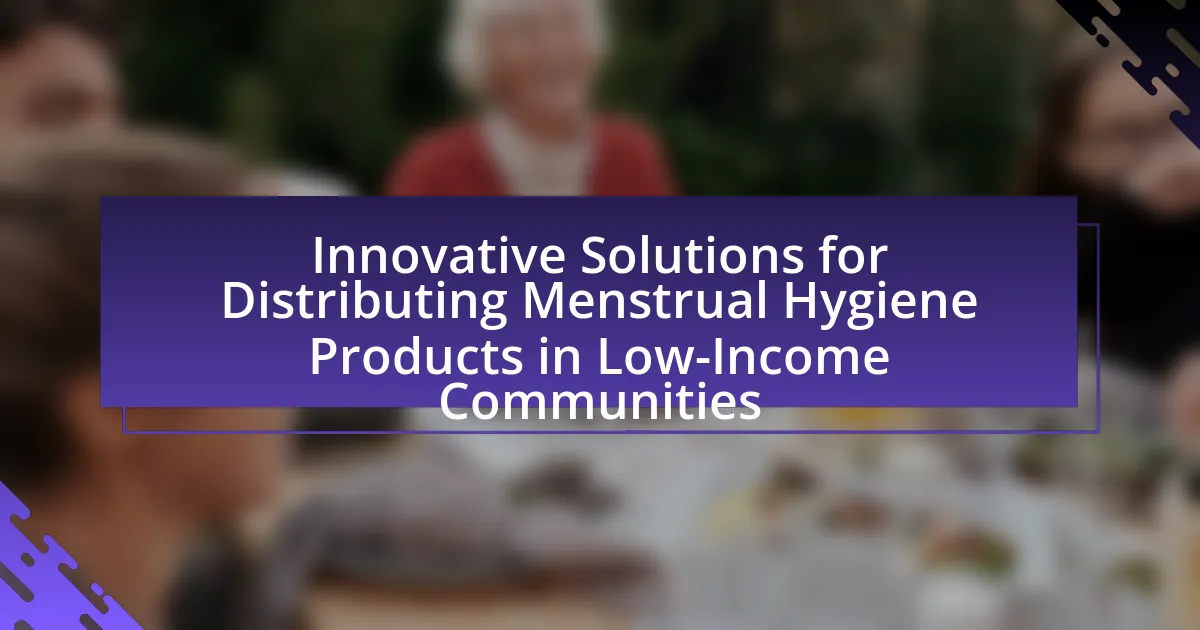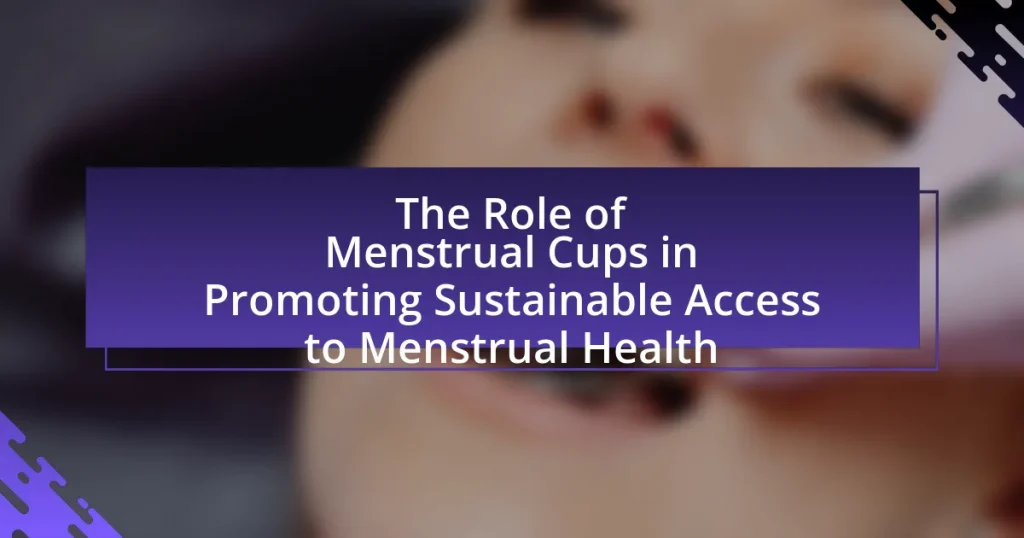The article focuses on innovative solutions for distributing menstrual hygiene products in low-income communities, highlighting the importance of accessibility, health, education, and gender equality. It discusses various distribution methods, including mobile units, community partnerships, and educational workshops, which enhance product availability and awareness. The article also addresses the challenges faced by these communities, such as financial constraints and cultural stigmas, while emphasizing the role of technology and community engagement in improving distribution efforts. Key factors for successful implementation and evaluation metrics are outlined, along with future trends and best practices for sustainable distribution solutions.

What are Innovative Solutions for Distributing Menstrual Hygiene Products in Low-Income Communities?
Innovative solutions for distributing menstrual hygiene products in low-income communities include mobile distribution units, community partnerships, and educational workshops. Mobile distribution units, such as vans or bicycles, can reach remote areas, ensuring accessibility. Community partnerships with local organizations can facilitate the distribution process, leveraging existing networks to reach those in need effectively. Educational workshops not only provide products but also inform individuals about menstrual health, fostering a supportive environment. For instance, a study by the Water Supply and Sanitation Collaborative Council found that integrating education with product distribution significantly improved menstrual hygiene management in underserved populations.
Why is the distribution of menstrual hygiene products important in low-income communities?
The distribution of menstrual hygiene products is crucial in low-income communities because it directly impacts health, education, and gender equality. Access to these products helps prevent health issues such as infections and promotes menstrual health management, which is essential for the well-being of individuals who menstruate. Furthermore, when menstrual hygiene products are readily available, it reduces absenteeism in schools, allowing girls to attend classes consistently. According to a study by the World Bank, lack of access to menstrual hygiene products can lead to up to 20% of school absenteeism among girls in low-income areas. This highlights the importance of distribution efforts in fostering educational opportunities and empowering women and girls in these communities.
What challenges do low-income communities face regarding menstrual hygiene?
Low-income communities face significant challenges regarding menstrual hygiene, primarily due to limited access to affordable menstrual products. Many individuals in these communities cannot afford basic sanitary items, leading to the use of unsafe alternatives, which can result in health issues such as infections. According to a study by the World Bank, approximately 500 million women and girls worldwide lack access to menstrual products, highlighting the scale of this issue. Additionally, inadequate sanitation facilities in low-income areas further exacerbate the problem, as many do not have private spaces to manage their menstrual hygiene safely and discreetly. This combination of financial constraints and poor infrastructure creates a cycle of stigma and health risks associated with menstruation in these communities.
How does access to menstrual hygiene products impact health and education?
Access to menstrual hygiene products significantly impacts health and education by promoting physical well-being and enabling school attendance. When individuals have access to these products, they experience fewer health issues such as infections and discomfort, which can arise from inadequate menstrual management. A study published in the journal “BMC Women’s Health” found that girls who lack access to menstrual hygiene products are more likely to miss school during their periods, leading to increased absenteeism and decreased educational attainment. Specifically, research indicates that in some regions, up to 20% of girls may miss school during menstruation due to inadequate supplies, which directly correlates with lower academic performance and future opportunities. Thus, ensuring access to menstrual hygiene products is crucial for both health and educational outcomes.
What innovative solutions currently exist for this distribution?
Innovative solutions for distributing menstrual hygiene products in low-income communities include mobile distribution units, community-based education programs, and partnerships with local organizations. Mobile distribution units, such as the “Pad Project,” deliver products directly to underserved areas, ensuring accessibility. Community-based education programs, like those implemented by “Days for Girls,” not only provide products but also educate on menstrual health, empowering women and girls. Additionally, partnerships with local organizations, such as NGOs and health clinics, enhance distribution networks and increase product availability, as evidenced by the collaboration between “Sheba Medical Center” and local NGOs in Israel, which successfully improved access to menstrual hygiene products for marginalized populations.
How do community-based initiatives contribute to effective distribution?
Community-based initiatives enhance effective distribution by leveraging local networks and knowledge to ensure that menstrual hygiene products reach those in need. These initiatives often involve collaboration with community leaders and organizations, which helps to identify specific needs and preferences of the population. For instance, a study by the Water Supply and Sanitation Collaborative Council found that community-driven approaches significantly improved access to hygiene products in low-income areas, demonstrating that local involvement leads to tailored solutions that resonate with the community’s cultural context. This localized strategy not only increases the distribution efficiency but also fosters trust and encourages community members to engage actively in the initiative.
What role do technology and mobile applications play in distribution?
Technology and mobile applications play a crucial role in the distribution of menstrual hygiene products by enhancing accessibility and efficiency. These tools facilitate real-time inventory management, allowing distributors to track stock levels and respond quickly to demand fluctuations. For instance, mobile applications can connect local suppliers directly with consumers, reducing the time and cost associated with traditional distribution channels. Additionally, technology enables targeted outreach through data analytics, helping organizations identify specific community needs and preferences. This targeted approach has been shown to increase product uptake in low-income areas, as evidenced by initiatives that have successfully utilized mobile platforms to distribute hygiene products effectively.
What are the key factors for successful implementation of these solutions?
The key factors for successful implementation of innovative solutions for distributing menstrual hygiene products in low-income communities include community engagement, accessibility, education, and sustainability. Community engagement ensures that the solutions are tailored to the specific needs and cultural contexts of the target population, fostering trust and participation. Accessibility involves ensuring that products are readily available and affordable, which can be achieved through partnerships with local organizations and distribution networks. Education is crucial for raising awareness about menstrual health and hygiene, empowering individuals to make informed choices. Sustainability focuses on creating long-term solutions that can be maintained over time, such as using locally sourced materials and training community members to manage distribution efforts. These factors are supported by successful case studies, such as the work of organizations like Days for Girls, which emphasizes community involvement and education in their programs, leading to improved menstrual health outcomes.
How can partnerships with local organizations enhance distribution efforts?
Partnerships with local organizations can significantly enhance distribution efforts by leveraging their established networks and community trust. Local organizations often have direct access to the target demographic, which facilitates more effective outreach and distribution of menstrual hygiene products. For instance, a study by the United Nations Population Fund highlights that local NGOs can improve access to essential health products by utilizing their existing relationships with community members, thereby increasing the likelihood of product acceptance and use. Additionally, these organizations can provide valuable insights into cultural sensitivities and logistical challenges, ensuring that distribution strategies are tailored to meet the specific needs of low-income communities.
What funding models support innovative distribution solutions?
Innovative distribution solutions for menstrual hygiene products in low-income communities are supported by several funding models, including social impact investing, grants from non-governmental organizations, and public-private partnerships. Social impact investing provides capital to organizations that aim to generate social benefits alongside financial returns, which is crucial for scaling distribution efforts. Grants from NGOs often target specific health initiatives, enabling organizations to implement innovative distribution strategies without the burden of repayment. Public-private partnerships leverage resources and expertise from both sectors, facilitating the development and distribution of menstrual hygiene products effectively. These funding models have been shown to enhance access and affordability, as evidenced by initiatives like the Global Financing Facility, which supports reproductive health programs in low-income countries.

How can we evaluate the effectiveness of these innovative solutions?
To evaluate the effectiveness of innovative solutions for distributing menstrual hygiene products in low-income communities, one can utilize metrics such as accessibility, user satisfaction, and health outcomes. Accessibility can be measured by the number of individuals receiving products compared to the target population, while user satisfaction can be assessed through surveys that gauge the perceived quality and availability of the products. Health outcomes can be evaluated by tracking changes in menstrual-related health issues, such as infections or school absenteeism, before and after the implementation of these solutions. For instance, a study published in the Journal of Global Health found that improved access to menstrual hygiene products significantly reduced school absenteeism among girls in low-income areas, demonstrating a direct correlation between product distribution and positive health outcomes.
What metrics are used to assess the impact of distribution initiatives?
Metrics used to assess the impact of distribution initiatives include reach, utilization rates, user satisfaction, and health outcomes. Reach measures the number of individuals or communities served by the initiative, while utilization rates indicate how frequently the distributed products are used. User satisfaction is often gauged through surveys that collect feedback on the products and distribution process. Health outcomes assess changes in menstrual health and hygiene practices, which can be evaluated through pre- and post-intervention studies. These metrics provide a comprehensive understanding of the effectiveness and impact of distribution initiatives in low-income communities.
How do we measure changes in health outcomes related to menstrual hygiene?
Changes in health outcomes related to menstrual hygiene are measured through various indicators such as the prevalence of reproductive tract infections, school attendance rates among menstruating individuals, and self-reported satisfaction with menstrual hygiene management. Research indicates that improved access to menstrual hygiene products correlates with reduced incidence of infections; for instance, a study published in the Journal of Water, Sanitation and Hygiene for Development found that access to sanitary products decreased the prevalence of reproductive health issues by 30% in low-income communities. Additionally, tracking school attendance can provide insights into the impact of menstrual hygiene on education, as studies show that girls with adequate menstrual hygiene resources are 20% more likely to attend school during their menstrual periods. These metrics collectively help assess the effectiveness of interventions aimed at improving menstrual hygiene in low-income settings.
What feedback mechanisms can be implemented to improve solutions?
To improve solutions for distributing menstrual hygiene products in low-income communities, implementing community surveys is essential. These surveys can gather direct feedback from users regarding their needs, preferences, and experiences with the products and distribution methods. Research indicates that participatory feedback mechanisms, such as focus groups and interviews, can enhance understanding of community-specific challenges and preferences, leading to more tailored solutions. For instance, a study by the Water Supply and Sanitation Collaborative Council found that engaging communities in the design and evaluation of hygiene programs significantly increased their effectiveness and acceptance.
What are the barriers to scaling successful distribution solutions?
The barriers to scaling successful distribution solutions for menstrual hygiene products in low-income communities include logistical challenges, limited infrastructure, and cultural stigmas. Logistical challenges arise from the need for efficient supply chains that can navigate remote areas, often hindered by poor transportation networks. Limited infrastructure, such as inadequate storage facilities and lack of access to reliable transportation, further complicates distribution efforts. Cultural stigmas surrounding menstruation can also impede acceptance and utilization of these products, affecting demand and distribution strategies. These factors collectively hinder the ability to implement and expand effective distribution solutions in these communities.
How do cultural perceptions affect the acceptance of menstrual hygiene products?
Cultural perceptions significantly influence the acceptance of menstrual hygiene products by shaping attitudes, beliefs, and practices surrounding menstruation. In many cultures, menstruation is stigmatized, leading to negative perceptions that can hinder the use of modern hygiene products. For instance, in some societies, traditional beliefs may dictate that menstruating individuals should avoid certain activities or spaces, which can create barriers to accessing and using products like pads or tampons. Research indicates that in regions where menstruation is viewed as a taboo subject, there is often a lack of education about menstrual hygiene, resulting in lower acceptance rates of these products. A study published in the Journal of Adolescent Health found that girls in communities with strong menstrual taboos were less likely to use sanitary pads, opting instead for less effective alternatives, which can lead to health risks. Thus, cultural perceptions play a crucial role in determining how menstrual hygiene products are accepted and utilized within different communities.
What logistical challenges must be addressed for wider distribution?
Wider distribution of menstrual hygiene products in low-income communities faces several logistical challenges, including inadequate transportation infrastructure, limited access to distribution points, and insufficient funding for outreach programs. Inadequate transportation infrastructure often leads to delays and increased costs in delivering products to remote areas, while limited access to distribution points can hinder availability in local markets or health facilities. Additionally, insufficient funding restricts the ability to implement effective outreach and education initiatives, which are crucial for raising awareness and ensuring proper usage of the products. Addressing these challenges is essential for improving access to menstrual hygiene products and promoting health equity in underserved populations.

What future trends can we expect in the distribution of menstrual hygiene products?
Future trends in the distribution of menstrual hygiene products will increasingly focus on accessibility through technology and community-based initiatives. Innovations such as mobile apps for product delivery and subscription services are expected to enhance convenience, particularly in low-income areas. Additionally, partnerships with local organizations will facilitate the distribution of eco-friendly and affordable products, addressing both environmental concerns and economic barriers. Research indicates that community-led initiatives can significantly improve access, as seen in programs like the Menstrual Health Hub, which emphasizes local engagement and education.
How is innovation shaping the future of menstrual hygiene product distribution?
Innovation is transforming the future of menstrual hygiene product distribution by leveraging technology and sustainable practices to enhance accessibility and affordability. For instance, mobile health applications are being developed to provide information on product availability and menstrual health education, particularly in low-income communities. Additionally, companies are increasingly adopting eco-friendly materials and subscription models, which reduce costs and environmental impact while ensuring a steady supply of products. Research indicates that these innovations can significantly improve access; a study by the World Bank found that improved distribution methods can increase product availability by up to 50% in underserved areas.
What emerging technologies could revolutionize distribution methods?
Emerging technologies that could revolutionize distribution methods include blockchain, drones, and mobile applications. Blockchain enhances transparency and traceability in supply chains, ensuring that menstrual hygiene products reach low-income communities efficiently. Drones can facilitate rapid delivery to remote areas, overcoming logistical challenges often faced in these regions. Mobile applications can streamline ordering and inventory management, allowing organizations to respond quickly to community needs. For instance, a study by the World Economic Forum highlights how blockchain can reduce fraud and improve accountability in supply chains, while research from the International Journal of Logistics Management demonstrates the effectiveness of drone delivery in reaching underserved populations.
How can sustainability be integrated into future distribution solutions?
Sustainability can be integrated into future distribution solutions by utilizing eco-friendly packaging, optimizing transportation routes, and implementing local sourcing strategies. Eco-friendly packaging reduces waste and environmental impact, while optimizing transportation routes minimizes carbon emissions and costs. Local sourcing supports community economies and decreases the carbon footprint associated with long-distance shipping. For instance, a study by the Ellen MacArthur Foundation highlights that sustainable packaging can reduce plastic waste by up to 70%, demonstrating the effectiveness of these strategies in promoting sustainability in distribution.
What best practices can be adopted for effective distribution in low-income communities?
Effective distribution in low-income communities can be achieved through community partnerships, targeted outreach, and culturally sensitive education. Community partnerships with local organizations enhance trust and facilitate access to resources, as evidenced by programs like the Menstrual Health Hub, which collaborates with grassroots organizations to distribute menstrual hygiene products effectively. Targeted outreach ensures that distribution efforts reach the most vulnerable populations, supported by data indicating that direct engagement increases product uptake. Culturally sensitive education addresses stigma and misinformation, as shown in studies where educational initiatives improved knowledge and acceptance of menstrual hygiene practices, leading to increased usage of distributed products.
How can community engagement enhance the success of distribution initiatives?
Community engagement enhances the success of distribution initiatives by fostering trust and collaboration between organizations and the target population. Engaged communities are more likely to participate in initiatives, provide valuable feedback, and help identify specific needs, which leads to more effective distribution strategies. For instance, a study by the International Journal of Environmental Research and Public Health found that community involvement in health initiatives significantly improved program acceptance and utilization rates. This demonstrates that when communities are actively involved, distribution initiatives are more likely to meet their intended goals and effectively address the needs of low-income populations.
What lessons can be learned from successful case studies in this field?
Successful case studies in distributing menstrual hygiene products in low-income communities demonstrate the importance of community involvement, tailored educational programs, and sustainable supply chains. Community involvement ensures that the solutions are culturally appropriate and meet the specific needs of the population, as seen in initiatives like the “Sheba Project” in Kenya, which engaged local women in distribution efforts. Tailored educational programs, such as those implemented by the organization “Days for Girls,” effectively raise awareness about menstrual health and hygiene, leading to increased product usage and reduced stigma. Additionally, establishing sustainable supply chains, as evidenced by the “Sustainable Menstrual Health Initiative,” ensures consistent access to products, thereby improving overall health outcomes. These lessons highlight the necessity of a holistic approach that combines local engagement, education, and sustainability for effective menstrual hygiene management in low-income settings.



